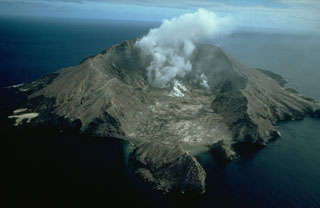Report on Whakaari/White Island (New Zealand) — 7 May-13 May 2025
Smithsonian Institution / US Geological Survey
Weekly Volcanic Activity Report, 7 May-13 May 2025
Managing Editor: Sally Sennert.
Please cite this report as:
Global Volcanism Program, 2025. Report on Whakaari/White Island (New Zealand) (Sennert, S, ed.). Weekly Volcanic Activity Report, 7 May-13 May 2025. Smithsonian Institution and US Geological Survey.
Whakaari/White Island
New Zealand
37.52°S, 177.18°E; summit elev. 294 m
All times are local (unless otherwise noted)
On 13 May GeoNet reported near-continuous emissions of gas, steam, and minor amounts of ash at Whakaari/White Island based on visual observations during overflights, visual observations from the Bay of Plenty coast, and from webcams located at Whakatane and Te Kaha. Additionally, minor amounts of ash were identified in satellite data as reported by the Wellington Volcanic Ash Advisory Center (VAAC). As seen from the coast, the plume occasionally rose 300-600 m above the summit during calm weather conditions, but during windier conditions the plume was lower and was visible downwind for tens of kilometers. Flights were occasionally canceled due to ash in the air. During overflights, scientists observed that the vent has not notably changed in size or shape. Although the vent temperature had increased to 460 degrees Celsius, it was still below the high of 650 degrees Celsius recorded in 2020 and 2021. Elevated temperatures were visible at night in the Te Kaha camera near infrared images. There were fewer new impact craters around the vent, suggesting less explosive activity. Temperature measurements, sulfur dioxide emissions identified in satellite data, and the amount of ash in the emissions remained steady over the past few months. The Volcanic Alert Level remained at 3 (on a scale of 0-5) and the Aviation Color Code remained at Orange (the second highest level on a four-color scale). GeoNet stated that the Alert Levels were reflective of the current level of activity, but there was uncertainty due to the lack of consistent, usable, real-time monitoring data; GeoNet relies on remote cameras, satellite images, and periodic overflights to monitor Whakaari.
Geological Summary. The uninhabited Whakaari/White Island is the 2 x 2.4 km emergent summit of a 16 x 18 km submarine volcano in the Bay of Plenty about 50 km offshore of North Island. The island consists of two overlapping andesitic-to-dacitic stratovolcanoes. The SE side of the crater is open at sea level, with the recent activity centered about 1 km from the shore close to the rear crater wall. Volckner Rocks, sea stacks that are remnants of a lava dome, lie 5 km NW. Descriptions of volcanism since 1826 have included intermittent moderate phreatic, phreatomagmatic, and Strombolian eruptions; activity there also forms a prominent part of Maori legends. The formation of many new vents during the 19th and 20th centuries caused rapid changes in crater floor topography. Collapse of the crater wall in 1914 produced a debris avalanche that buried buildings and workers at a sulfur-mining project. Explosive activity in December 2019 took place while tourists were present, resulting in many fatalities. The official government name Whakaari/White Island is a combination of the full Maori name of Te Puia o Whakaari ("The Dramatic Volcano") and White Island (referencing the constant steam plume) given by Captain James Cook in 1769.
Source: GeoNet

